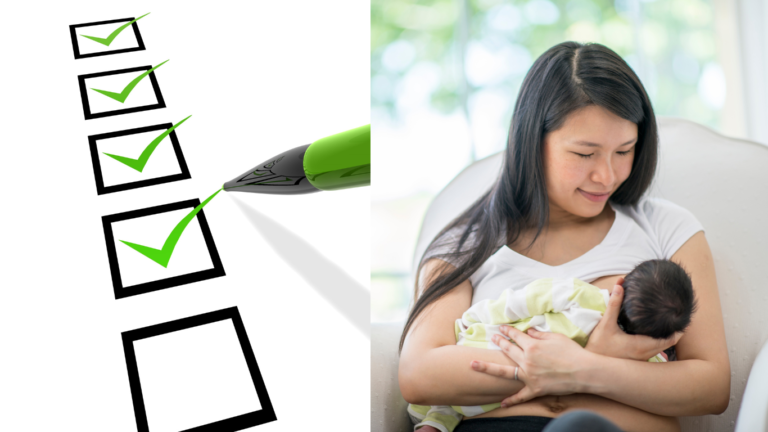Reverse Pressure Softening
Breastfeeding is a natural process between a mother and her baby that provides essential nutrients and bonding opportunities for them both. It can however come with some challenges! In the first few days of breastfeeding, when the breasts start filling with more milk, some women experience full, firm breasts that can be painful to manage.
Luckily there are great ways to manage this challenge, one of which is reverse pressure softening. In this article, we’ll explore what reverse pressure softening is and how it works to help relieve engorgement.
You may find it difficult to attach your baby even if they’ve latched well beforehand without a problem. It can also be really hard to get the milk flowing due to the breast tissue being inflamed and blocking the passage of milk through the ducts.
What is Reverse Pressure Softening?
Reverse pressure softening (RPS) is a technique used to help relieve engorgement and assist the letdown reflex when breastfeeding.
Engorgement occurs when the breast tissue becomes very full and inflamed, causing the breast to become swollen, hard, and painful.
The letdown reflex is the amazing process by which milk is released from the breast in response to the baby’s sucking.
RPS involves applying gentle pressure to the breast tissue surrounding the nipple, which causes the fluid to move away from the nipple into the lymphatic system temporarily.
This process softens the areola and surrounding tissue, allowing the milk to flow, and making it easier for the baby to latch on and feed.
How does RPS assist breastfeeding?
RPS is beneficial for both the mother and her baby. Engorgement can be very uncomfortable for mums, as the pressure builds up in the breast tissue.
Having a very full breast makes the milk difficult to move as it compresses the ducts. Once the pressure is removed, the milk can flow more easily to the baby or the pump if a mum is expressing.
RPS can help facilitate the letdown reflex, which is essential for successful breastfeeding. If the letdown reflex is not working correctly, the milk may not flow as well and just keep building up within the breast.
When the breast is full it can actually slow down production, so it’s vital to keep removing milk frequently and flexibly according to the baby’s needs.
It can also be harder for the baby to draw the nipple into their mouth deeply and bring the milk out when there is too much pressure in the breast.
A baby who cannot latch may become frustrated or start to refuse the breast altogether. Removing the pressure from the breast helps the baby latch better by softening the area around the areola.
Feeding from a very full and firm breast can also be very overwhelming for a little baby. When the letdown occurs, the pressure can make it more forceful and difficult for the baby to keep up with the flow.
This may cause them to pull away, cough or splutter, and cause them distress. Removing the pressure can help ease the force of the letdown and allow the baby to manage the flow much more comfortably.
Reverse Pressure Softening Technique
New insights into breast tissue and milk production have brought new recommendations, and reverse pressure softening is a great technique to use.
Let’s walk through the newest recommendations and the steps of reverse pressure softening together.
1. Get in a comfortable position where you can expose your breast and be prepared with a cloth or breast pad to soak up any milk that may move forward, out of the nipple.
You can use reverse pressure softening on top of clothing if you aren’t in a space you are comfortable exposing yourself.
2. If your nipples are tender or healing from damage, the milk that leaks forward is great to lubricate the nipple and soften it, so when your baby latches it may ease the initial latch pain.
Breast milk is also very healing as it contains anti-fungal and antibacterial properties, so it’s great to use before any other nipple balms.
3. Position all of your fingers of both hands close to your nipple and around the areola on both sides of the breast. Otherwise, you can use your whole hand on top of your clothing and press toward the chest wall if you need.
4. Push firmly towards the chest wall with all of your fingers (or your whole hand if on top of clothing) and hold your breast in this position for around one to two minutes.
It may feel a little uncomfortable at first but many mums find they start to feel relief from the pressure after a short time.
Once the breast feels softer and you see milk moving through the nipple more freely you can try to bring your baby to the breast and latch, hopefully finding the breast easier to manage.
Techniques to avoid
Applying heat: Your breasts will most likely already be warm due to the excess fluid buildup and inflammation so no need for a warm compress. Heat can actually irritate an already inflamed breast and make it worse.
Deep tissue massage: Breast tissue is very delicate so avoid massaging the breast deeply and excessively to try and push the milk out. An already inflamed breast can become worse if you rub it with too much force.
Express milk before nursing: It’s ideal to avoid removing too much milk with pumping or hand expressing if your baby is latching to the breast frequently, and efficiently. Removing excess milk can worsen engorgement as the body works harder to replace the milk taken out before the baby removes what they need. This can create an oversupply and it’s best to avoid it if you can.
Reverse pressure softening is a useful technique that can help alleviate engorgement, help your baby latch, and facilitate the letdown reflex in breastfeeding. It’s important to remember that breastfeeding can be challenging, and it may take you both time and practice to get the hang of it.
If you’re experiencing discomfort or difficulties with breastfeeding, don’t hesitate to reach out to me for a consultation. With patience and perseverance, you can overcome the challenges and enjoy a fulfilling breastfeeding experience with your baby.
Still struggling with full, uncomfortable breasts and need help? Get in contact with me now here.







